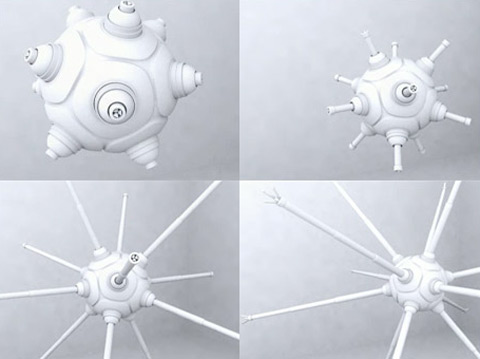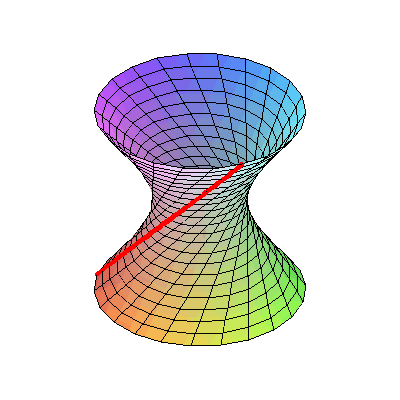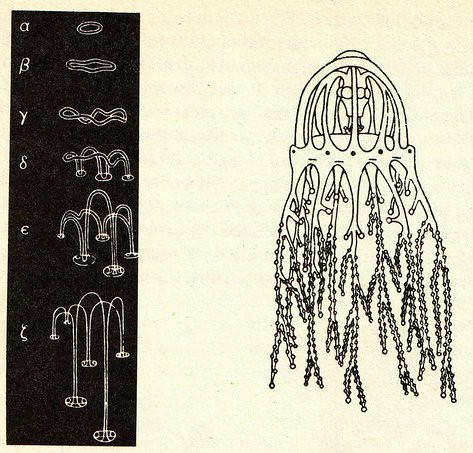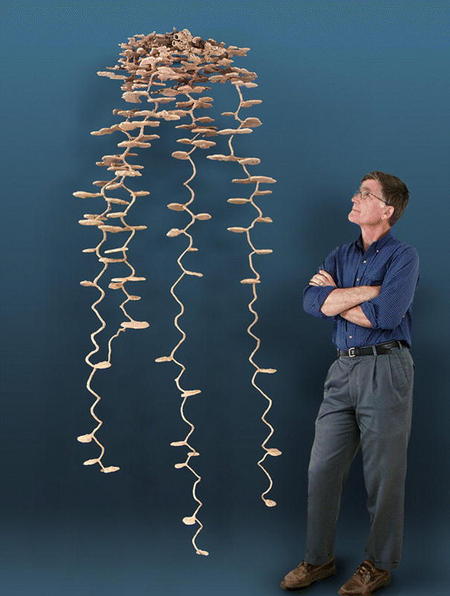This 3d dimensional spinning Zeotrope piece is incredible. It is called Die Falle and is currently on display at the Science Gallery as part of their fantastic exhibiton Illusion.
science
A Squid Responds to Cypress Hill
The chromatophores in a squid stimulated by Cypress Hill's Insane in the Membrane.
More info here

Utility Fog is a hypothetical collection of tiny robots, envisioned by Dr. John Storrs Hall while he was thinking about a nanotechnological replacement for car seatbelts. The robots would be microscopic, with extending arms reaching in several different directions, and could perform lattice reconfiguration. Grabbers at the ends of the arms would allow the robots (or foglets) to mechanically link to one another and share both information and energy, enabling them to act as a continuous substance with mechanical and optical properties that could be varied over a wide range. Each foglet would have substantial computing power, and would be able to communicate with its neighbors.
More info here
Temari Balls

"Temari balls are a traditional Japanese craft in which colored thread is applied to a sphere in a geometric pattern. This is a modern example, given to me by the Japanese master Kiyoko Urata."
Taken from a post by George Hart via Make
Timelapse Video of Mushrooms
Unusual Geometric Shapes
 This animated image shows a structure called a hyperboloid of one sheet. It is a curved form made up of only straight lines and is one of several strucutre discussed in this blog post by "Miss Cellania" (via boingboing).
This animated image shows a structure called a hyperboloid of one sheet. It is a curved form made up of only straight lines and is one of several strucutre discussed in this blog post by "Miss Cellania" (via boingboing).
Giant Hole in Guatemala City
 This photo was taken from the Guatemalan Government's Flickr feed and shows a "massive, spontaneous sinkhole ("hundimiento") that appeared today in Zone 2 of Guatemala City, after overwhelming saturation of rains from tropical storm Agatha."
This photo was taken from the Guatemalan Government's Flickr feed and shows a "massive, spontaneous sinkhole ("hundimiento") that appeared today in Zone 2 of Guatemala City, after overwhelming saturation of rains from tropical storm Agatha."
More at boingboing
Tania Kovats - Tree
 Here's a video documenting the production of Tania Kovats' artwork Tree made for the Natural History Museum in London.
Here's a video documenting the production of Tania Kovats' artwork Tree made for the Natural History Museum in London.
The artwork is a slice cut from the centre of a real oak tree and was inspired by the work of Charles Darwin.
Concrete Cast of Enormous Ant Colony
"A giant ant colony pumped full of cement,and then excavated reveals one of Mother Nature's marvellous wonders.
We've seen what these giant ant mounds look like above ground but this is an incredible view of what the structures looks like underground - which some have called a wonder of the world."
3d Printing with Paper

There is an Irish company called Mcor Technologies who have developed a machine for 3d printing using layers of ordinary paper and PVA glue. The Models shown here were created entirely by the machine. Below is a video from the late late show.
The Nerve - Music and the Human Experience
 The Nerve - Music and the Human Experience is a six part radio series. The first episode, which dealt with how we perceive music, was played as the lyric feature last Saturday evening.
The Nerve - Music and the Human Experience is a six part radio series. The first episode, which dealt with how we perceive music, was played as the lyric feature last Saturday evening.
All of the episodes except the fifth be listened to here (not sure why the fifth isn't available).
The titles of the episodes are below.
Episode 1: Wired for Sound (Music & the Brain)
Episode 2: In the Key of DNA (Music & Evolution)
Episode 3: The Pipe, the Drum and the Thunder Run (Music & War)
Episode 4: Enchanted, Entranced (Music & Spirituality)
Episode 5: myTunes (Music & Identity)
Episode 6: Sentimental Journey (Music & Emotion)
Slime Mould Imitates Tokyo Rail System
 "The researchers decided to task the slime mold with a problem human designers had already tackled. They placed oat flakes (a slime mold favorite) on agar plates in a pattern that mimicked the locations of cities around Tokyo and impregnated the plates with P. polycephalum at the point representing Tokyo itself. They then watched the slime mold grow for 26 hours, creating tendrils that interconnected the food supplies. Different plates exhibited a range of solutions, but the visual similarity to the Tokyo rail system was striking in many of them"
"The researchers decided to task the slime mold with a problem human designers had already tackled. They placed oat flakes (a slime mold favorite) on agar plates in a pattern that mimicked the locations of cities around Tokyo and impregnated the plates with P. polycephalum at the point representing Tokyo itself. They then watched the slime mold grow for 26 hours, creating tendrils that interconnected the food supplies. Different plates exhibited a range of solutions, but the visual similarity to the Tokyo rail system was striking in many of them"
A Geometry of the Pitted, Pocked, and Broken Up
This quote from James Gleick's book Chaos: Making a New Science
Clouds are not spheres, Mandelbrot is fond of saying, Mountains are not cones. Lightning does not travel in straight lines. the new geometry mirrors a universe that is rough not rounded, scabrous, not smooth. it is a geometry of the pitted, pocked, and broken up, the twisted, tangled, and intertwined. The understanding of nature's complexity awaiting a suspicion that the complexity was not just random, not just accident. It required a faith that the interesting feature of lightning was not its direction, but rather the distribution of zigs and zags. Mandelbrot's work made a claim about the world, and the claim was that such odd shapes carry meaning. The pits and tangles are more than blemishes distorting the classic shapes of Euclidian geometry. They are often the key to the essence of a thing.
D'arcy Wentworth Thompson

These illustrations by D'Arcy Wenworth Thompson show the shapes made by drops of ink in water (left) and the tentacles of a jellyfish (right).
They are taken from a book called Chaos: The Amazing Science of the Unpredicatable by James Gleick and originally appeared in Wentorth Thompson's book On Growth and Form 
The Drunkard's Walk
Ì have just finished reading a book about randomness called The Drunkard's Walk: How Randomness Rules Our Lives
One of the interesting facts in the book is that people are not capable of making up a sequence of numbers that pass mathematical tests for randomness. For certain mathematical calculations strings of random numbers are required. In 1947 scientists at the RAND corporation created a system using electronic noise to generate random numbers. They did not succeed in generating a string of numbers that was entirely free of regularities but did produce results which were random enough to be useful. The numbers were published in 1955 as A Million Random Digits
I looked up the RAND book on Amazon and found a strange user review :
This is surely the most depressing book I have ever read. I am an amateur historian, who has spent many years analysing history and watching it repeat itself... or at least that is what I thought. After reading this book it is obvious that what I perceived to be recurring patterns, were if fact just random events being repeated randomly.
As a result, I no longer read history with the same enthusiasm. On the bright side, this book is a wonderful testament to man's ability to think the unthinkable. It also questions my sanity that I tried to read it in the first place!
Here is another from Amazon:
I took a class in statistics in college. I used this book to help me select random phone numbers for a poll I was conducting for my class project. (The most popular household cleanser in the greater Siouxland area is Bon Ami, by the way.) One of those phone calls was answered by the woman who is now my wife. We've been happily married for ten years! Thank you, RAND.
Below are three graphs from Mlodinow's books which I also found interesting:
 They show an example of 'normal distibution'. To explain this idea Mlodinow writes about an experiment in which 300 students were each asked to guess heads or tails in a series of ten coin tosses. When these results are presented in a graph they form a bell-shaped curve centred on 5 correct guesses. The curve drops to about two thirds of its maximum height between 3 and 4 correct guesses and between 6 and 7 correct guesses and tapers off in a bell shape with 0 and 10 correct guesses having the lowest heights. This type of curve is know as 'normal distribution'.
They show an example of 'normal distibution'. To explain this idea Mlodinow writes about an experiment in which 300 students were each asked to guess heads or tails in a series of ten coin tosses. When these results are presented in a graph they form a bell-shaped curve centred on 5 correct guesses. The curve drops to about two thirds of its maximum height between 3 and 4 correct guesses and between 6 and 7 correct guesses and tapers off in a bell shape with 0 and 10 correct guesses having the lowest heights. This type of curve is know as 'normal distribution'.
The graphs below chart the number in rows of pascal's triangle - a chart which can be used to show the number of possible combinations of given set of elements eg the number of ways 100 people can be seated at 10 tables.
Model of Copper Particle

Here is a "model calculation of a copper particle with the size of 17000 atoms - a cluster which plays a role in catalytic processes." from this website of the research center DESY in the west of Hamburg
Cast of an Anthill

